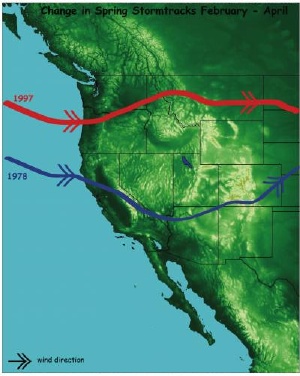Aug 20 2008
Human-driven changes in the westerly winds are bringing hotter and drier springs to the American Southwest, according to new research from The University of Arizona in Tucson.
 The late-winter/early-spring storm activity in the western US has shifted north since the late 1970s. This graphic shows how the peak winter storm tracks have shifted poleward since 1978. The blue line shows the storm track for February, March and April of 1978. The red line shows the track for the same months during the year 1997.
Credit: Stephanie McAfee, the University of Arizona, 2008.
The late-winter/early-spring storm activity in the western US has shifted north since the late 1970s. This graphic shows how the peak winter storm tracks have shifted poleward since 1978. The blue line shows the storm track for February, March and April of 1978. The red line shows the track for the same months during the year 1997.
Credit: Stephanie McAfee, the University of Arizona, 2008.
Since the 1970s the winter storm track in the western U.S. has been shifting north, particularly in the late winter. As a result, fewer winter storms bring rain and snow to Southern California, Arizona, Nevada, Utah, western Colorado and western New Mexico.
"We used to have this season from October to April where we had a chance for a storm," said Stephanie A. McAfee. "Now it's from October to March."
The finding is the first to link the poleward movement of the westerly winds to the changes observed in the West's winter storm pattern. The change in the westerlies is driven by the atmospheric effects of global warming and the ozone hole combined.
"When you pull the storm track north, it takes the storms with it," said McAfee, a doctoral candidate in the UA's department of geosciences.
"During the period it's raining less, it also tends to be warmer than it used to be," McAfee said. "We're starting to see the impacts of climate change in the late winter and early spring, particularly in the Southwest. It's a season-specific kind of drought."
Having drier, warmer conditions occur earlier in the year will affect snowpack, hydrological processes and water resources, McAfee said.
Other researchers, including the UA's Laboratory of Tree-Ring Research Director Tom Swetnam, have linked warmer, drier springs to more and larger forest fires.
McAfee's co-author Joellen L. Russell said, "We're used to thinking about climate change as happening sometime in the future to someone else, but this is right here and affects us now. The future is here."
McAfee and Russell, a UA assistant professor of geosciences, will publish their paper, Northern Annular Mode Impact on Spring Climate in the Western United States, in Geophysical Research Letters, a journal of the American Geophysical Union. The National Oceanic and Atmospheric Administration funded the research via the Climate Assessment for the Southwest program at the UA.
Atmospheric scientists have documented that the westerly winds, or storm track, have been shifting poleward for several decades. The southwestern U.S. has experienced less winter precipitation during the same period.
Computer models of future climate and atmospheric conditions suggest the storm track will continue to move north and that precipitation will continue to decrease in the southwestern U.S.
The timing of the change from wet, cool winter weather to the warmer dry season is important for many ecological processes in the arid Southwest. Therefore, McAfee wanted to know how the shift in the storm track affected precipitation during the transition from winter to spring.
For the period 1978 to 1998, the researchers compared the month-to-month position of the winter storm track, temperature and precipitation records from the western U.S., and pressure at different levels in the atmosphere.
The team used a statistical method called Monte Carlo simulations to test whether the coincidence of storm track and weather patterns had occurred by chance.
Russell said the results of the simulation showed, "It's very rare that you get this distribution by chance." Therefore, she said, the changes in late winter precipitation in the West from 1978 to 1998 are related to the changes in the storm track path for that same time period.
McAfee said her next step is investigating whether western vegetation has changed as the storm track has changed.